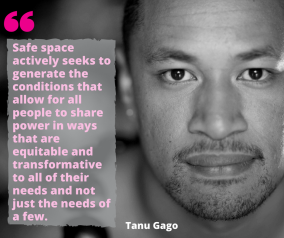Manu Vaea: “How are you supposed to feel about a place you once came from, that doesn’t technically exist anymore?”
Manuha’apai Vaeatangitau is the full name is the artist commonly known as Manu Vaea. The 19 year old Tongan visual artist and poet has responded to the themes of gentrification and cultural transformation in the PIMPI Winter Series exhibition, #CHANGES with a series of rose-tinted, hand-drawn illustrations about the erasure of memory and the emotional detachment of displacement.
Manu, your four hand-drawn works in #CHANGES feel so personal; they give us such intimate insights into family spaces. What was it like to draw, in painstaking detail, these memories?
Upon drawing these, I felt sadness. That’s just it, an overwhelming sadness. I had decided upon the exclusion of a large part of my family’s facial features and some figures completely so that it would feel a bit emotionally off-kilter/detached because I guess that’s what gentrification does on that level. How are you supposed to feel about a place you once came from, that doesn’t technically exist anymore?
Your work makes a vital contribution to this exhibition because it demonstrates what the ‘end game’ of gentrification can look like. What was the experience like for your family to be displaced and relocate to another community, presumably much further away from the environment they were familiar with?
My family weren’t and still aren’t so interested in the politics of displacement and gentrification; I attribute this to it being something they must’ve become accustomed to, living in New Zealand. So, I guess that’s why, as I looked through the old photographs from Mad Ave and further began to illustrate them, I felt so upset.
My family had actually moved from Mad Ave shortly before the process of gentrification had begun, but it’s that thing of being able to locate yourself within a time and place. A whole community of families had existed there, a culture had developed there and these are the things that you don’t see in those articles dogging Mad Ave or honestly any other area with a low socio-economic decile.
Gentrification happened to everyone, so in turn, everyone one was displaced together and recreating these communities wasn’t too hard. I think the physical erasure of these low socio-economic areas that both my family and many others grew up in, as I mentioned before, leaves a lot of people really emotionally detached. I think it also slowly but definitely eventuates in the erasure of memories.
I became aware of your practice through my lifelong fangirling of all things FAFSWAG, what does it mean to be part of this collective, and how does that influence or empower your individual practice?
Ah! FAFSWAG. It means a lot to be a part of the collective. The members of this collective were the first to actually want to sit down with me and discuss things I had always wanted to discuss. FAFSWAG has given me huge opportunities to create/perform/be and I’m mad thankful. In regards to my individual practice, I’ve made sure not to really expect too much and feel pressured to overachieve because I need to take care of my spirit/body/mind first and well, I’m only 19. Lol. FAFSWAG, however, is one of my greatest support systems and I feel really indebted towards a lot of the members.
I know you’re currently studying visual arts at AUT University, having moved from studying animation, what are you loving about making art without a kind of commercial orientation?
Yes, so I’m currently sitting a Bachelor of Visual Arts and what I love about the lack of any kind of commercial orientation is that I’m creating things that I feel wholly responsible for. In saying that, it also means that I take full responsibility if my work looks like shit. I think that even that is good for growth though. I also just appreciate that I get to speak on whatever I want, whenever I want and I am always in complete control of what I share with others. Trying to head down a more traditionally lucrative career path (going to Media Design School) was honestly a really bad mistake which manifested itself in many ways physically, mentally and spiritually.
It’s so good to have those things in check at such a young age. Manu, what are your art dreams… what is the ideal art life for you?
Hmm, art dreams. I haven’t really thought about it properly. Its all just been go from the jump so I’ve taken everything as it came. I think really what I want is to travel, create outside of my comfort zone and ultimately return to Tonga.
Check out Manu Vaea’s new work in #CHANGES until Friday 28 July at Lime Espresso Bar & Eatery, 507 Great South Road, South Auckland.















































